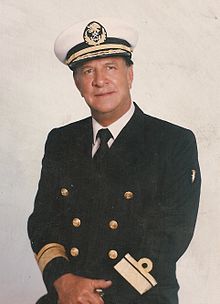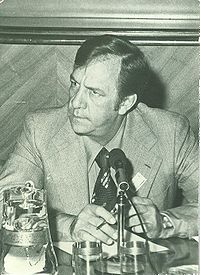- Miguel Ángel Barberena Vega
-
Miguel Angel Barberena Vega Governor of Aguascalientes In office
December 1, 1986 – November 30, 1992Preceded by Rodolfo Landeros Gallegos Succeeded by Otto Granados Roldán Personal details Born August 4, 1928
Jesús María, AguascalientesDied June 17, 1999 (aged 70)
Pabellón de Artega, AguascalientesPolitical party PRI Spouse(s) Miriam Cruz Valdes Alma mater Autonomous University of Aguascalientes Profession Geographical Engineer Miguel Ángel Barberena Vega was born in Jesús María, Aguascalientes on August 4, 1928. He spent his childhood in an old Hacienda called “Los Cuartos”. He dies at Pabellón de Arteaga, Aguascalientes in June 1999.
Contents
History
His primary studies were conducted until the 4th year in the municipal school of Jesús Maria and finishes at “Sons of the Army” school in Cuernavaca Morelos. Middle school as well as high school studies are performed at the Autonomous Institute of Sciences, now called Autonomous University of Aguascalientes.
He finishes high school in 1946 and by 1947 he decides to join the Navy of Mexico. He gets the degree of Geographical Engineer of the Heroic Naval Military School and graduates in 1951 getting the higher grade from his generation.
He gets commissioned for various units of the Mexican Navy as a midshipman and is destined for various units of this institution, in the Gulf coasts and the Pacific. In January 1953 he takes his professional examination for the title of engineer geographer and obtained the rank of Lieutenant Commander General of the Mexican Army Corps.
He’s commissioned to various units of the Navy as a gunnery officer and Chief of Navigation. In May 1955 he wins a scholarship given by the University of Veracruz to make studies on the prestigious University of Michigan where he completed graduate studies in Nuclear Engineering. In 1958 he was commissioned of the Navy Department at the University of Veracruz, where he joins as a full time professor in its School of Engineering at the Port of Veracruz. Simultaneously that same year, he lectures at the Heroic Naval Academy. By May of that same year he is appointed Secretary of the Faculty of Engineering.[1]
In 1961, when the Veracruzana University created its Institute of Science, he was appointed Founding Director of this institution until December 1962 when he was invited by the National Polytechnic Institute (IPN) to take over the National Computer Center in Mexico City and set up an IBM-709, the largest computer in Latin America in its time (1963).
On December 1, 1964 he was appointed General Director of Railways in Operation, under the Secretariat of Communications and Transportation, by agreement of the President Gustavo Díaz Ordaz. (1964–1970). In 1970, during the presidential campaign of Luis Echeverria Alvarez, was appointed Officer of the Institute of political, economic and social studies (IEPES in Spanish) in the state of Veracruz.
In 1970 In 1970 occupies a curule as Senate, representing his home state in the XLIX and XLVIII Legislatures. He joins tasks partisan, first in 1971, as the officer of the National Confederation of Popular Organizations (CNOP in Spanish) in the State of Nuevo León, and then as General delegate to the PRI in the State of Baja California Norte. In March 1973 is the Secretariat of organization of the National Executive Committee (CEN)[2] of the Institutional Revolutionary Party (PRI), and at the same time is a Professor of the Faculty of Engineering of the National Autonomous University of Mexico (UNAM) from 1968-1974.[1]
In October 1975, at the end of his term as Secretary General of the PRI's CEN was appointed General Delegate in the State of Jalisco, and in March 1976, in the State of Baja California. He is designated PRI's CEN regional officer during the campaign of José López Portillo.
On December 1, 1976 he’s designated Subsecretary of Communications and Transportation, ending his term on 1982. At the conclusion of its management in this position in September 1981, he joined Miguel de la Madrid as political adviser of the Ministry of Press and Propaganda of the Executive Committee the PRI national campaign.
In January 1983 he was appointed General Delegate of the PRI’s National Executive Committee (CEN) in South Baja California, and in March 1984 for the State of Hidalgo.
On September 20, 1984 is promoted to the rank of Rear Admiral by President Miguel de la Madrid and commissioned major presidential State.
He is postulated by the Institutional Revolutionary Party as candidate for federal deputy for the second district of Aguascalientes and was elected on July 7, 1985. He was a member of the Electoral College and secretary of the board of the same. He was Chairman of the Committee on energy during the LIII Legislature and member of the Committee of communications and transportation and Marine.
On 30 May 1986 was designated as the PRI pre candidate to the State Government. By December 1986 takes office as the constitutional Governor of the State for the period 1986-1992.
When his term was finished, he became leader of the Popular Sector of the PRI presidential campaigns of Luis Donaldo Colosio and Ernesto Zedillo during the years 1993-1994. Within the Navy of Mexico, he held the rank of Vice-admiral.
He got married with Mrs. Miriam Cruz Valdez with whom he had 6 children: Miguel Angel, Marco Antonio (†), Mario Alberto (†), Manuel Alejandro (†), Martín Andrés and Marina.
Political Activities
- 1970-1976 Senator of Aguascalientes for the XLVIII Legislature of the Institutional Revolutionary Party (PRI)
- 1985-1986 Federal Deputy
- 1986-1992 Governor of Aguascalientes
- 1972-1976 Secretary General of CEN
- General Delegate in the States of Jalisco, Baja California, South Baja California, Nuevo León and Hidalgo.
- Leader of the Popular Sector (PRI)
Government Administration
He supported industrialization and trade, He created the Institute of Housing as well as the commercial corridor of Expoplaza and the expansion of the Bullring. Built the Highway Aguascalientes-León and Aguascalientes Theater, promoted the creation of the Office of Citizen Protection. Initiated proceedings for the recovery of the Arquitos Cultural centre. Mr. Miguel Ángel Barberena Vega died on 17 June 1999 leaving a legacy of effort, responsibility and commitment to each other
References
- ^ a b Mora, Mario (1992). Miguel Ángel Barberena Vega. Perfil Humano de un sexenio 1986-1992. Aguascalientes: Gobierno del Estado, Instituto Cultural de Aguascalientes. ISBN 9682943213.
- ^ Comité Ejecutivo Nacional del PRI "[1]" 2010
External links
Categories:- Governors of Aguascalientes
- 1928 births
- 1999 deaths
Wikimedia Foundation. 2010.


